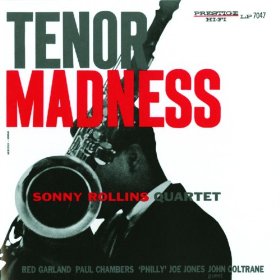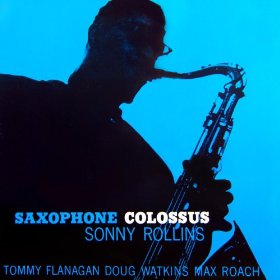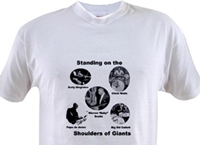
Although I had the opportunity to dig deeper, I did not want to dilute Coltrane's accomplishments, so this post is going to focus on Rollins. A good starting point is this excellent BBC documentary about Sonny:
That Rollins and Coltrane were mutual admirers is amply shown in This Trane fell through the cracks. While they shared many things in common, including both starting on alto before taking up tenor, there were key differences between the two. A key difference is how Rollins would keep reinventing himself, while Coltrane evolved in a seamless, almost logical way to musical concepts that continue to exert major influence on all genres of music.
Rollins' influence, while perhaps not as far reaching across genres, is significant within jazz and has reached audiences who would not consider themselves to be jazz aficionados.
As a musician you will find him worth studying because of his highly rhythmic style, which he established as early as 1957 with his ground breaking piano-less trio format. The composition or that format was a drummer and bassist. If you are a drummer or bassist, then I need not tell you how valuable his recordings in that format are for studying importance of bass in an ensemble. Two excellent 1957 albums that showcase this format are A Night At The Village Vanguard and Way Out West. Here is a clip from the afternoon set from the A Night At The Village Vanguard album. The album is divided into two sets: afternoon featuring Pete LaRoca on drums and Don Bailey on bass and evening featuring Elvin Jones on drums and Wilbur Ware on bass. Here is Miles Davis' Four with Laroca and Bailey:
It's easy to judge fast tempo music like Four, but a real test of a piano-less trio - in my opinion - is how well they handle ballads and slower tempo material. This track from Way Out West features the great Ray Brown on bass and the equally great Shelly Manne on drums:
As innovative as the two albums mentioned are, Rollins will forever be remembered by two others: Tenor Madness and Saxophone Colossus.

Tenor Madness: This 1956 album preceded another landmark Rollins' masterpiece, Saxophone Colossus, and is also an important album because of the collaboration between Rollins and John Coltrane on the title track.
Other personnel on this album were Red Garland on piano, Paul Chambers on bass and Philly Joe Jones on drums. John Coltrane is only on track 1, Tenor Madness.
Twelve minutes of Rollins and Coltrane on track 1 is reason enough to own this album. Hear for yourself:
However, there are no duds among all of the tracks. A bit of trivia: Paul's Pal was written in honor of Paul Chambers (whose bass on this album is worth a close listen, as is Red Garland's piano.) Indeed, the entire line-up is like a Miles Davis reunion, and Chambers and Coltrane would go on to be members of the ensemble that recorded one of the best selling jazz albums of all time, Kind Of Blue.

Recorded the same year as his earllier Masterpiece, Tenor Madness, Rollins hits another one out of the park with this album.
The line-up here is completely different from Tenor Madness, with Tommy Flanagan on piano, Doug Watkins on bass and Max Roach on drums. Watkins is a bassist to whom I pay close attention, which makes this album all the more valuable to me. He was Charles Mingus choice to replace himself (so he could play piano) on Oh Yeah, and had Watkins not died at 27 he had the potential to be one of jazz's top bassists.
Of course Saint Thomas is the reason most non-jazz aficionados love this album. Instead of providing a clip of that song from the album I am going to include one of my favorite live performances with a different line-up as an example. My reason is the interplay between the great Niels-Henning Orsted Pedersen on bass and Tootie Heath on drums is a study in importance of bass, and especially with respect to Rollins' own contribution to the rhythm. Kenny Drew is on piano:
As much as I love St. Thomas, my personal favorites from the album are are Moritat (also known as Mack the Knife) and Blue 7.
However, personal favorites aside, I hold every track on this album to be a masterpiece. Not a bad effort for a 26 year old who had previously that year made a landmark album that would be hard to top. Whether he managed to top those achievements is an argument that I'll leave to others. What he did in the ensuing 56 years is continue to perform, inspire and make an indelible mark on music. I am going to end this post with later performances and leave it to you to explore his music throughout its many reinventions.



No comments:
Post a Comment